Dangerous products that have to be stopped at the border, withdrawn from the market or even recalled from end consumers by the European authorities are reported to the European Union’s Safety Gate on a weekly basis. The Safety Gate, also known as the Rapex system, is the European information exchange system through which the market surveillance authorities of the member states inform each other about dangerous products.
If products are classified as dangerous or harmful in a member state, the national market surveillance authorities generally take this as an opportunity to withdraw the products from the market in these countries as well.
We have analyzed the data from the last four years and come to some very interesting conclusions:
In 2023, a total of 3,418 alerts were made on the Safety Gate. This is 53% more notifications than in the previous year and by far the most notifications in recent years.
An average of 66 reports were made per week in 2023 compared to 43 reports in 2022.
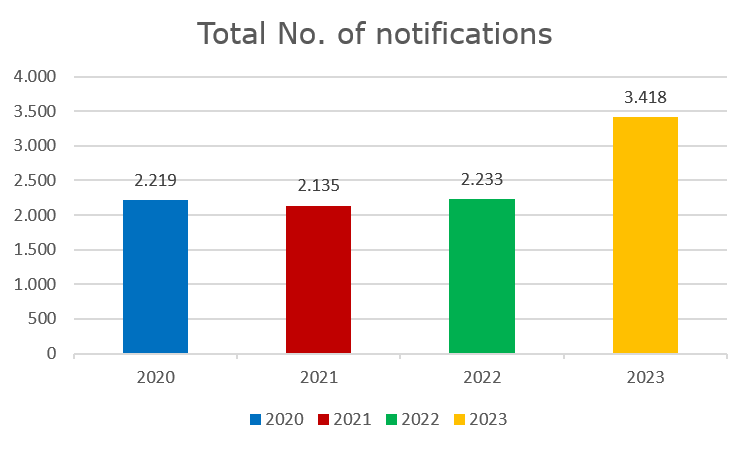
Looking at the affected product groups, most of the products reported in 2023 were cosmetics. With a total of 1,091 reported products, 100 cosmetics were subject to sales bans or even product recalls almost every month.
More than 400 reports concerned the product categories toys (466 reports = 13.7%), electrical products including lighting and multi-media products (417 > 12.2%), motor vehicles (416 > 12.2%) and clothing, textiles, fashion and baby articles (401 > 11.7%).
While the number of dangerous toys reported fell slightly compared to the previous year, the number of reports increased significantly, particularly for electrical products and textiles.
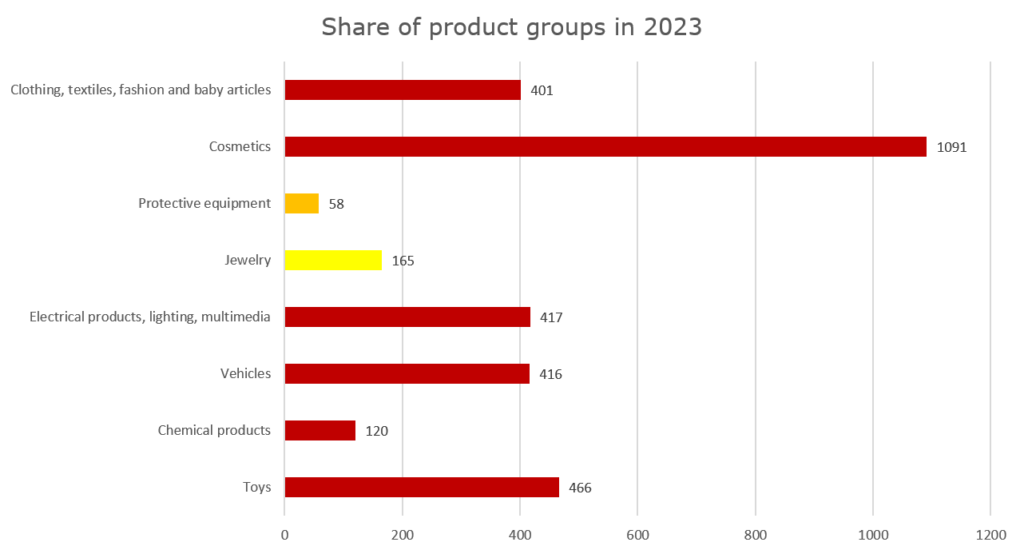
As in the previous year, the number of reports in the area of protective equipment continued to fall due to the fact that hardly any respiratory masks were tested. The increase in chemical products, which now account for almost 4% of products classified as hazardous, is noteworthy. This product group includes a wide variety of products such as paints, adhesives and cleaning agents, but tattoo inks and electronic cigarettes and their ingredients were the most frequently complained about.
Chemicals were again the number one hazard in 2023. With 1,738 reports, chemical risks were responsible for more than 50% of the products that were the subject of complaints and banned. In addition to the more than 1,000 cosmetics whose main risks were of chemical origin (over 95% of cosmetics contained BMHCA, which is banned in cosmetic products), baby products, clothing, jewelry, toys and sports and leisure articles were also affected.
706 or 20.7% of the products in question posed a risk of various injuries, cuts or damage to sight or hearing, followed by just over 300 products (8.8%) that could lead to electric shock or fire.
Of the 200 products that posed a risk to the environment, 167 were in breach of the RoHS Directive. This is a further indication that the authorities are paying more and more attention to compliance with the defined limits for electrical products and are issuing sales bans and product recalls in the event of infringements.
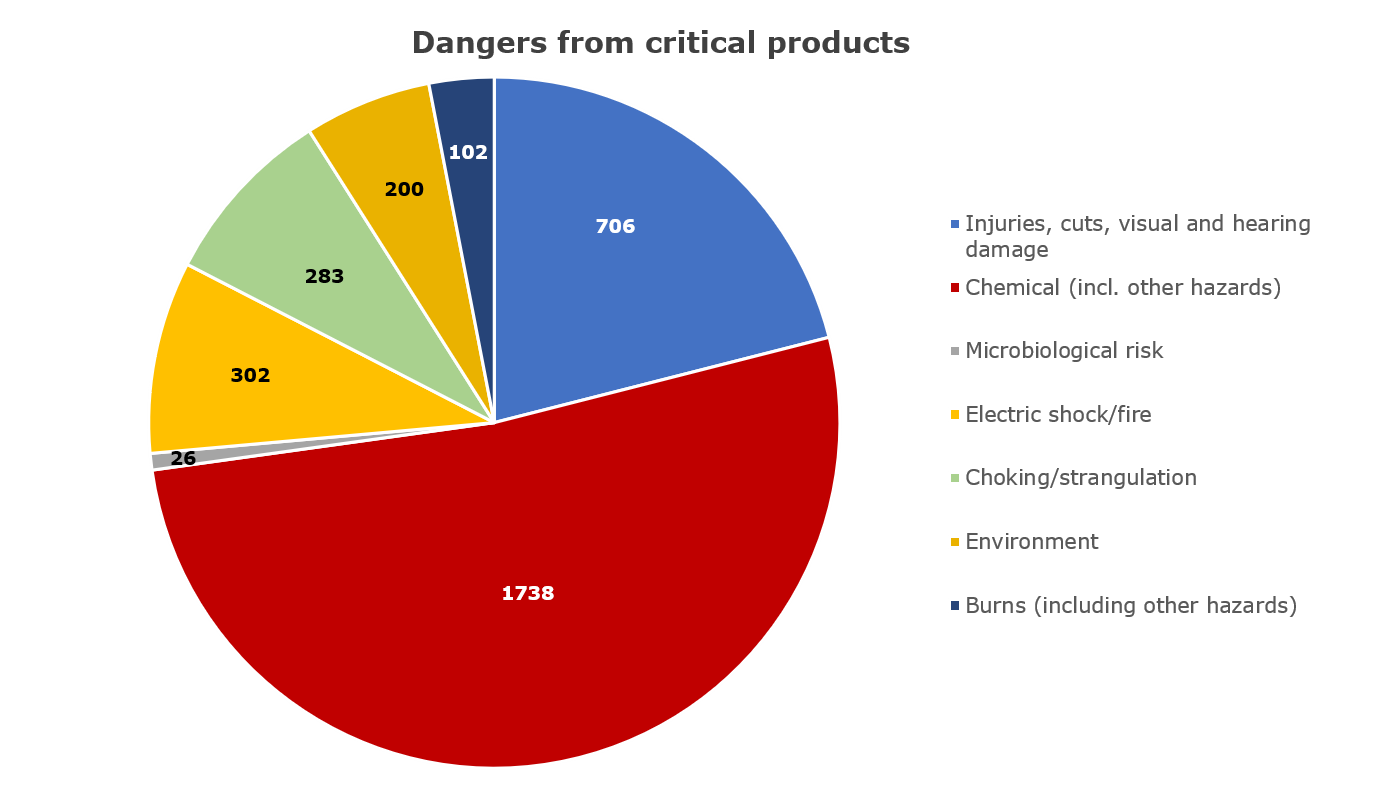
As in previous years, the People’s Republic of China accounted for by far the largest number of offending products. 1,250 products or 36.6% were imported from this country. Due to the very high number of cosmetics reported, the proportion of Chinese products in all rejected products fell significantly from almost 50% in 2022, but the absolute number continued to increase.
Surprisingly, products from Italy were the second most complained about product in 2023. This is due to the fact that 355 of the 526 critical products in total came from the cosmetics sector – the product category that was subject to intensive scrutiny last year, particularly by the Italian and Hungarian market surveillance authorities.
Click here for a free initial consultation:

https://produkt-compliance.de/en/free-initial-consultation
Products from Spain, Poland and France were also more affected than in previous years in terms of countries of origin. More than 66% of products from Spain and Poland came from the cosmetics sector, while 55% of products from France did so.
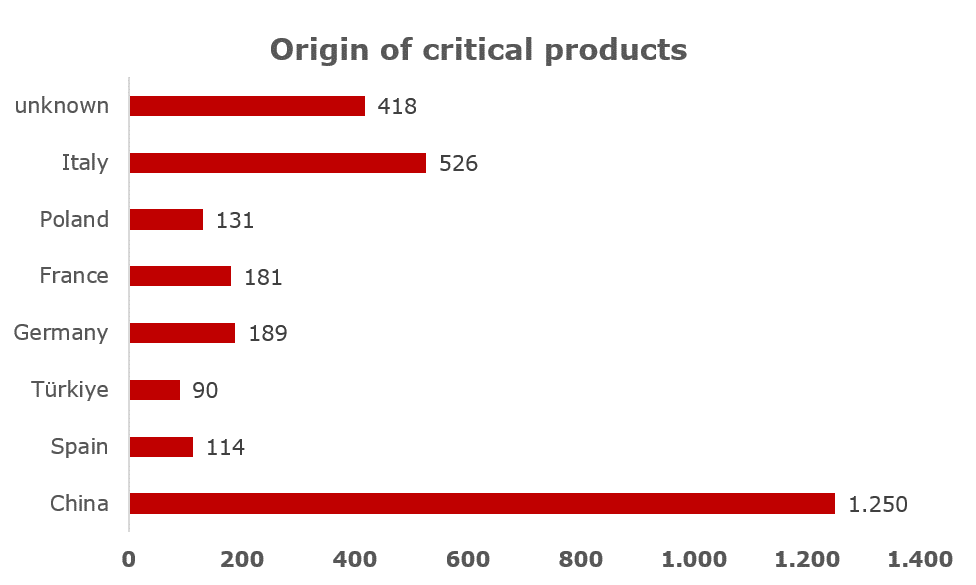
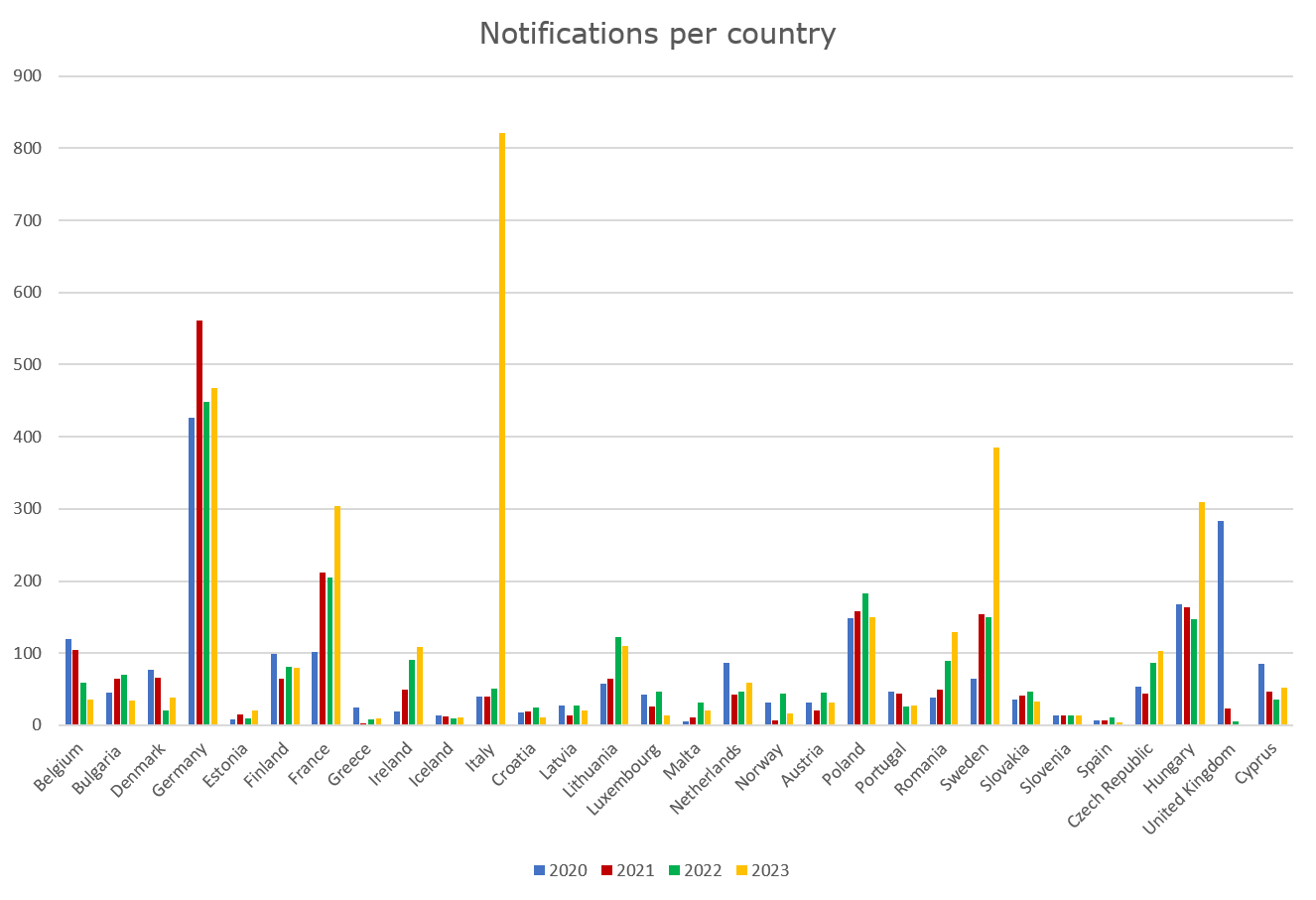
Unlike in previous years, most of the reports in 2023 came from Italy, where an extremely high number of cosmetics were tested and objected to. While Italy had only submitted 51 reports in the previous year, in 2023 there were a total of 821, an increase of 1,500%. 80% of the reported products from Italy concerned cosmetics.
Many notifications also came from Germany, Sweden, France and Hungary. The Hungarian authorities also apparently focused on analyzing cosmetics in 2023, as 55% of the reported products were cosmetics.
While notifications in most European countries remained at a similar level to the previous year, Sweden submitted 150% more notifications than in 2022. While Italy and Hungary focused heavily on cosmetics, the Swedish market surveillance authorities mainly analyzed electrical products (39.5% of all notifications), jewelry (16.1%) and toys (10.6%), most of which were withdrawn from the market.
It seems obvious that highly populated countries such as Germany, France or Poland report more products as dangerous in absolute terms than much smaller countries such as Latvia, Luxembourg or Cyprus. But what happens if you include the size of the population in this analysis and examine the reports per 1 million inhabitants? The results here are very interesting:
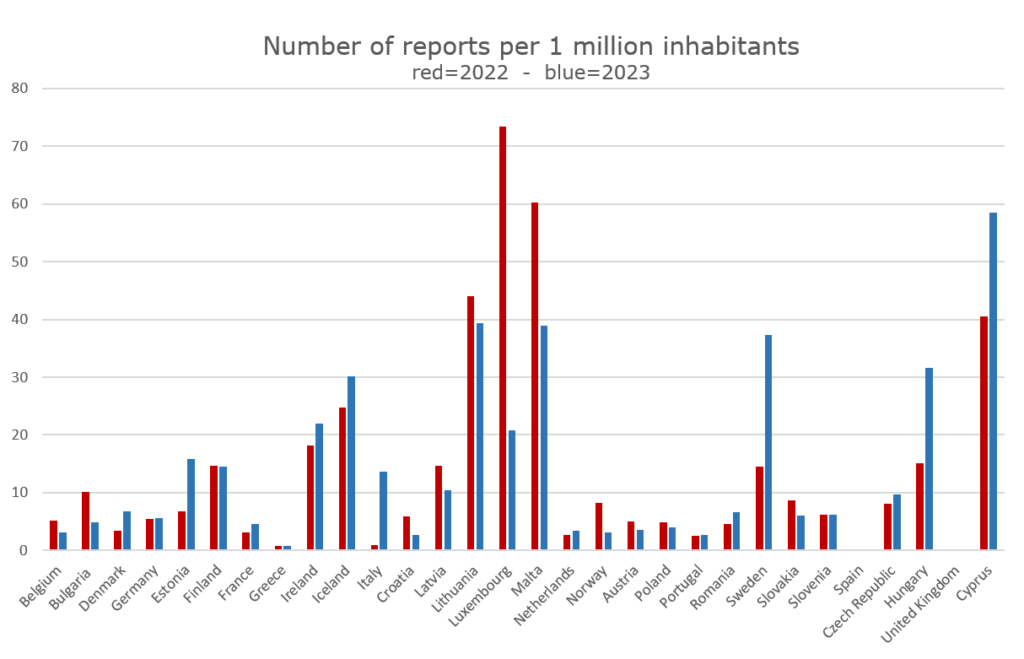
On average, the European member states reported a total of around 6.6 products per 1 million inhabitants as hazardous in 2023 (basis: population per member state on 1.1.2020 according to Eurostat). This is just under 2.3 products more than in 2022. Germany is slightly below this average with a factor of 5.6. The leader in this analysis is Cyprus with 58.6 notifications per 1 million inhabitants. Countries such as Lithuania (39.4), Malta (38.9), Sweden (37.3) and Hungary (31.6) are also extremely active.
In contrast, Spain (0.1) and Greece (0.8) are hardly or not at all active. Portugal (2.6), Croatia (2.7), Belgium (3.1) and Norway (3.2) also scored below average. Italy’s activities in the cosmetics sector in 2023 placed it in the front midfield with 13.6 notifications per 1 million inhabitants, while last year it was still one of the countries with the fewest notifications.
This observation shows that many smaller countries in particular are quite active in the area of market surveillance in relation to their population. At the same time, it is surprising that in some of the larger countries, testing is apparently almost non-existent. If one assumes that the markets in Spain, Greece and Portugal market similarly unsafe products to those in the other EU countries, it is hard to understand why there are so few tests in these countries.
The sharp increase in the number of dangerous products that have been reported to all other member states via the Safety Gate shows that the market surveillance authorities have significantly expanded their activities. In addition, the focus on certain product categories in individual countries shows that the member states are coordinating more closely with each other and can therefore act much more efficiently.
The risk of non-compliant products being discovered by the market surveillance authorities and subject to sales bans or product recalls has increased significantly.
According to a study by Allianz, product recalls of electrical goods or toys can result in costs of between €650,000 and €1,000,000. Import bans can also easily cost between €50,000 and €100,000, even for medium-sized deliveries, not to mention additional fines for customers and loss of image.
We recommend that our customers attach much greater importance to product compliance management, random testing and, above all, complete and reliable documentation in order to avert considerable damage.
We are happy to help you set up a suitable risk management system and support you during the conformity assessment process. This includes determining product-specific requirements, preparing technical documentation, risk analysis and designing complete and up-to-date EU declarations of conformity.
Make an appointment today for a free initial consultation
